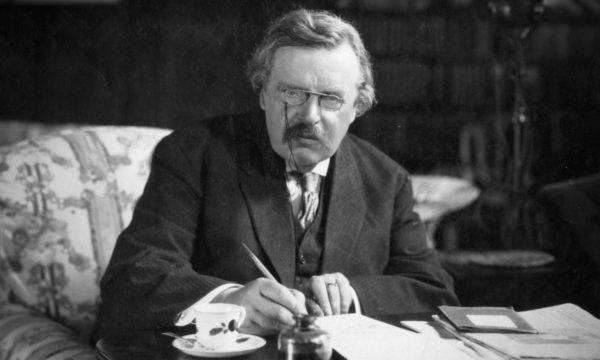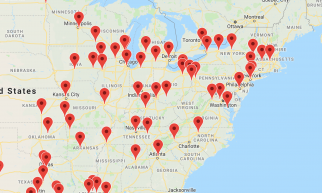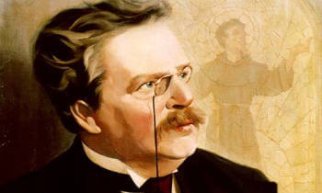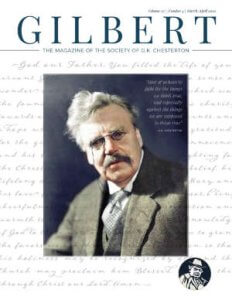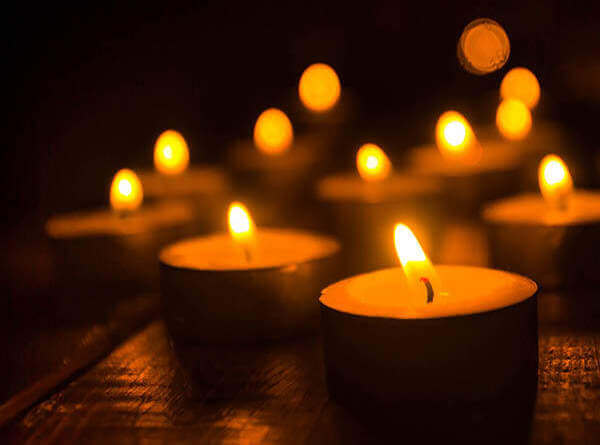I could sit here and write some very creditable creepy tale, about how I went up the crooked road beyond the church and met Something -say a dog, a dog with one eye. Then I should meet a horse, perhaps, a horse without a rider; the horse also would have one eye. Then the inhuman silence would be broken; I should meet a man (need I say, a one-eyed man?) who would ask me the way to my own house. Or perhaps tell me that it was burnt to the ground. I think I could tell a very cosy little tale along some such lines. Or I might dream of climbing forever the tall dark trees above me. They are so tall that I feel as if I should find at their tops the nests of the angels; but in this mood they would be dark and dreadful angels; angels of death.
Only, you see, this mood is all bosh. I do not believe in it in the least. That one-eyed universe, with its one-eyed men and beasts, was only created with one universal wink. At the top of the tragic trees I should not find the Angel’s Nest. I should only find the Mare’s Nest; the dreamy and divine nest that is not there. In the Mare’s Nest I shall discover that dim, enormous opalescent egg from which is hatched the Nightmare. For there is nothing so delightful as a nightmare when you know it is a nightmare…
Therefore, I see no wrong in riding with the Nightmare to-night; she whinnies to me from the rocking tree-tops and the roaring wind; I will catch her and ride her through the awful air. Woods and weeds are alike tugging at the roots in the rising tempest, as if all wished to fly with us over the moon, like that wild amorous Cow whose child was the Moon Calf. We will rise to that mad infinite where there is neither up nor down, the high topsy-turveydom of the heavens. I will answer the Call of Chaos and Old Night. I will ride on the Nightmare; but she shall not ride on me.
G.K. Chesterton did not really write many short stories, and those that he did write were not really short stories. The problem is that some of his essays were not essays. They seem to be stories. But they are not really one or the other. There is a narrative and it fills up the space usually taken by an essay. There are enough of these that when laid out end-to-end, the resulting confusion seems like a collection of short fiction. None of this is a criticism, mind you. It is just another example of the problem of Chesterton the uncategorizable.
Marie Smith compiled these Chesterton pieces and called the collection Daylight and Nightmare, making the claim that even when he seemed to be writing in the highest of spirits, “horrors were never far away.” She is backed up not only by the passage above (from a Daily News essay called “The Nightmare”) but by the great Argentine writer Jorge Luis Borges, who was a huge Chesterton fan, singing his praises in the darkest of eras: the 1970s.
“Chesterton restrained himself from being Edgar Allan Poe or Franz Kafka,” wrote Borges, “But something in the makeup of his personality leaned towards the nightmarish, something secret, and blind, and central…”
I don’t know.
Anybody with a good imagination can imagine evil in unlikely and unwelcome manifestations. Who doesn’t believe that the dark hides things that we don’t want to know about? It doesn’t mean that these fears are “central.” I think we have to trust Chesterton when he says he will ride the nightmare and not let the nightmare ride him. It is a ride he takes only occasionally, and in any case, he is in control.
And as a matter of fact, these stories are not terrifying. And in most cases, as I have already pointed out, they are not stories. “The Picture of Tuesday” anticipates The Man Who Was Thursday. “The Roots of the World” anticipates “The Romance of Orthodoxy” in Orthodoxy. “The Conversion of an Anarchist” stands alone as an answer to Ibsen’s A Doll’s House. “The Angry Street” is startling but delightful, with a real punch line. But the collection in the end leaves us wanting more. It does not live up to its theme, it does not live up to even being a collection of stories. It leaves us wishing that Chesterton actually had spent more time putting his great talent to work on writing short narratives that really tell a tale with a beginning, middle and end. Instead we only have fragments, fetching, suggestive, mysterious, enlightening, pointing to something eternal, or simply pointing to something about to appear from around the corner. But always to Daylight.

